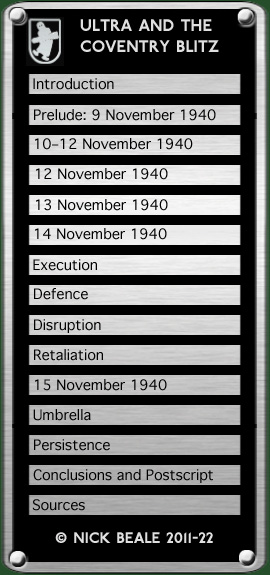|
That so much of the Bletchley’s CX/JQ report from 14 November is given over to interpreting Y-Service material appears to be because analysts currently had very little of their own and were keeping busy until the Luftwaffe’s keys could again be broken. Ultra had nothing to say about the coming night’s attacks—such warnings as it had been able to provide had all been given by the early hours of the 12th. The deciphered information on the beam alignments for Wolverhampton, Birmingham and Coventry was a major clue, the more so when combined The numbers 1, 2, 3 and 4 on the captured I. Fliegerkorps map had misled the RAF in their efforts to identify Moonlight Sonata’s target(s). This is understandable since the various Intelligence branches had no reason to trust one talkative and comparatively low-ranking prisoner more than documentary evidence. The nature of the misunderstanding is clear from call sign F4GD’s reports from the skies over Coventry of bombs in target areas 1 and 3—the numbers denoted parts of that city. Should Ultra’s KORN have been recognised as Coventry? Although the Germans did not always “disguise” their targets so thinly, PAULA had been identified as Paris on 31 May and LOGE had likewise been recognised as London well before the Mondschein Sonate signal while on 22 June, Bletchley had commented on a German message about a planned "Undertaking [i.e.Unternehmen] Strassburg": Considering the German habit in Norway of using Decknamen [cover names] beginning with the same letter such as OLDENBURG for OSLO, BREMEN for BERGEN etc., “undertaking STRASSBURG” may be not unconnected with the tender interest shown by the Germans in SOUTHAMPTON [in a signal of 10.30 hrs. on 21 June]. Then CREME and HANS were mentioned as targets for 17 July, Bletchley suggesting that: “These code-names might stand for CROMER and HULL”. When it comes to interpreting KORN, Britain is lacking in towns whose names begin “Ko…”; conversely the German language has few if any nouns beginning “Co…” so “Ko…” is the obvious substitute (just as English renders Köln and Koblenz as Cologne and Coblenz). The choice of UK industrial or population centres beginning with “Co…” is limited but might include Colchester, Consett (then home to a major steelworks but probably out of range of the German beams), Corby (another iron and steel town) and Coventry. With all that, it would not have been that great a leap to make the KORN = Coventry connection but the documents do not suggest that this was done before the raid and indeed the identification was still only tentative in a decrypt produced the following night. This was a part of a report on British AA defences and decoy sites from Bristol through the Midlands, based on observations by Luftwaffe aircrew: … On 12–13/11 at “BILD” heavy AA fire, well-directed. At “KORN” (? Coventry …) heavy AA fire, more concentrated E. than W. of the city … On 29–30/10 at KORN were 2 dummy fires in the city area, which flare up when approached. On 27–28/10, 10 km. N. of KORN, a dummy blast-furnace. To confuse matters, when Southampton was blitzed on 30 November, Aschenbrenner’s aircraft sent two signals: 18.12 GMT: “Korn 8 large fires” 18.18 GMT: “Korn 20 large fires” So, after the success of Moonlight Sonata, was “Korn” used to mean “target area” or “aiming point”? Communication between intelligence agencies was another issue, Dr. R.V. Jones has written that he had not seen Felkin’s report on the revelations made by Ltn. Probst. Further, a Bletchley Park officer wrote to his Director on 16 November: You will have observed that the breaking performed by Hut 6 is becoming increasingly difficult.
continued on next page …
|
|||

 with Probst’s revelations. The identification of the targets from the figures was not undertaken at Bletchley however; Dr. R.V. Jones of Air Intelligence writes that he plotted the bearings.
with Probst’s revelations. The identification of the targets from the figures was not undertaken at Bletchley however; Dr. R.V. Jones of Air Intelligence writes that he plotted the bearings. He complained that his team was not seeing the RAF’s data on beam frequencies, bearings and times of operation, any of which would have served as valuable “cribs” for breaking “Brown”, the key used by the beam stations. The Y-Service’s Gp. Capt. L.F. Blandy apparently believed that external information would “contaminate” the decrypts and Bletchley was at pains to stress that it wanted the material “for breaking and not intelligence purposes.” Evidence from prisoner interrogations was also requested.
He complained that his team was not seeing the RAF’s data on beam frequencies, bearings and times of operation, any of which would have served as valuable “cribs” for breaking “Brown”, the key used by the beam stations. The Y-Service’s Gp. Capt. L.F. Blandy apparently believed that external information would “contaminate” the decrypts and Bletchley was at pains to stress that it wanted the material “for breaking and not intelligence purposes.” Evidence from prisoner interrogations was also requested.